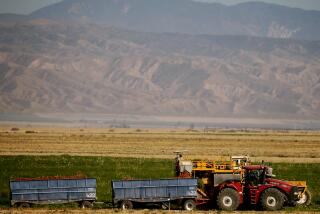Closing a Chapter in the City’s Sinful Water History
Want to be an expert on the Owens Valley-Los Angeles water controversy, the one that was in the news this week when a deal was struck to abate valley dust storms that resulted from the city’s water policies? It’s simple. Just rent the 1974 film “Chinatown” and take some notes.
Or at least that’s what more than a few people have told me when they learned I had written a book about the controversy. “Oh, yeah. ‘Chinatown.’ ”
But water history doesn’t get written in Hollywood. For that, it’s better to rely on a number of well-researched books that have been published on the city’s most notorious water controversy. These books provide some perspective not just on L.A.’s water wars but on the entire question of balancing urban needs with environmental concerns.
The Owens Valley dispute began in 1905 when agents acting for Los Angeles bought up Owens River water options under questionable circumstances. After the completion of the aqueduct in 1913, matters settled down for a decade, only to flare up again in the water wars of the 1920s. Los Angeles ultimately bought out hundreds of farmers and businessmen and obtained complete control of the valley’s river system.
The city’s actions brought severe criticism from the state Legislature in the 1930s. Meanwhile, Los Angeles grew far beyond the expectations of even the most optimistic boosters. From 200,000 people in 1905, the city topped a million in 1930, and more than 3 million in the 1990s. I wish that today’s city residents had a thirst for history to match that thirst for water.
In 1905, the city’s population was overwhelmingly white Anglo Saxon Protestant. The success of Los Angeles as the economic center of Southern California invited the arrival of a population during the century that is culturally, religiously and otherwise diverse, and to a great extent unaware of how Los Angeles got this way.
Ask any of the recent arrivals (recent meaning, say, 30 years or so) where the water they use for drinking, bathing, washing and sprinkling their lawns comes from. The answer usually is the water faucet. Yes, but before it gets to the faucet, where did it come from? Blank stares, then the guesses: the Los Angeles River, those mountains over there or maybe somehow from the ocean.
Identify Mulholland, Sherman, Chandler, Huntington, Hellman. Yes, they’re the names of streets, but they’re also the names of people connected with the phenomenal growth of Los Angeles. Were the city boosters evil men? Robert Towne, who wrote the screenplay for “Chinatown,” mutters on TV about how the names on the public monuments belong to people who should have been put in prison, but this is nonsense. Their actions benefited themselves and their city, and for decades Los Angeles’ view of its water rights and its economic and political influence was perceived as the correct recipe for municipal greatness.
We could ease the pressure on our resources by requiring everyone to count off by twos and march off the unlucky ones into the Pacific, as one environmentalist has all but suggested. But this is hardly a realistic solution. Inevitably, as our population increases, the drain on resources will continue despite our most conscientious efforts.
Times have changed since 1970, the year that Los Angeles completed a second aqueduct and continued its policy of diverting the streams that fed into Mono Lake. A general environmental consciousness now exists to some degree among the city’s residents, even if the city’s history remains vague. We know that, after years of litigation, the Mono Lake Committee won a major victory over the city, saving the lake.
Periodically, politicians from the city and Owens Valley announce settlements on such issues as ground water drainage and property rights. The city seems to have reached the point now where it can deal honorably with the dust storm problem. Elected officials and Los Angeles Department of Water and Power commissioners represent a generation more sensitive to environmental concerns, a generation far different from the one that at the beginning of this century advocated that the greatest good should go to the greatest number.
More to Read
Sign up for Essential California
The most important California stories and recommendations in your inbox every morning.
You may occasionally receive promotional content from the Los Angeles Times.









